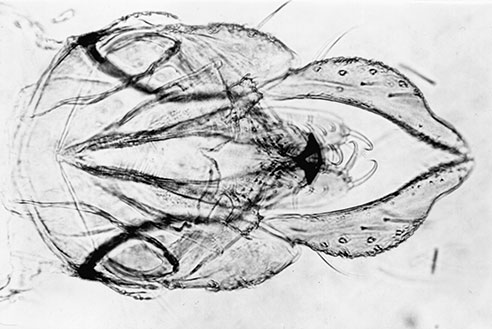Einfeldia australiensis (Freeman, 1961)According to Cranston (Cranston et al. 2016) the type series is mixed. The Holotype is Einfeldia, but two of the paratypes are an undescribed species of Xenochironomus. Adult: Wing length about 2.75-3.5 mm, VR 1.07; AR about 2.7; LR1 1.57-1.65; LR2 0.46-0.48; LR3 0.55-0.60. Fore tarsal beard sparse, BR 5.0. Colour greenish; thorax yellow-brown with vittae scarcely darker; legs green, forelegs with darker tibia and tarsomeres, mid and hind legs with dark tarsomeres; abdomen light green becoming darker posteriorly. Freeman classed the thorax as green with yellowish-red thoracic vittae. Frontal tubercles present (Freeman stated they were absent) globular, about 5-7 µm across. Palpal proportions (segs. 2 - 5) 50-65 : 120-175 : 150-200 : 210-320. 15-18 clypeal setae. Thorax with antepronotal lobes narrow dorsally and fused at shallow notch, slight indication of a scutal tubercle. Setae - 19-21 acrostichals in irregular biserial row, 6-11 dorsocentrals, 5-6 prealars, about 16 scutellars in two rows. Dorsomedial setae of TIX in pair of clusters, about 11-20 in each cluster. Anal point thick and heavily downturned. Gonostylus slightly widened in midsection, tapering slightly at tip.  Pupa: (described by Cranston): Length about 7 mm, medium brown, with weak abdominal apophyses. Cephalic tubercle roughly conical, abt 70 µm long and with short (about 20 µm) pale seta. Larva: Rather like a Kiefferulus larva in gross morphology. Length about 7-12.5 mm, no lateral tubules, one pair of ventral tubules about 1.08-1.16 mm in length; anal tubules about 260-360 µm long and about twice as long as wide. Cytology: 3 polytene chromosomes with little evidence of the Keyl arms. However the arm corresponding to arm G is fused to one arm, possibly arm E, of a previously metacentric chromosome (confirmed by presence of 4 polytene chromosomes in other Einfeldia species). The fused arm G has two BRs but no nucleolus. The nucleolus is developed near the middle of an arm of another chromosome. The two metacentric chromosomes have heterochromatic bands which probably represent the centromeres. Unfortunately the cytology of most specimens is unclear due to being too young or less than ideal original fixation, but one other larva lacked the second BR of the presumed arm G. Molecular Data: Australian Capital Territory - Lake McKenzie, Jervis Bay (35.06°S, 150.68°E). New South Wales - Blue Lagoon dune lake; Pond #3, Botany wetlands, Sydney (33.935°S, 151.208°E); Oxford Falls (type locality -types in BNHM, London). Queensland - Ocean Lake, Fraser Island (24.925°S, 153.273°E). South Australia - Lake Edward, nr. Kalangadoo (37.63°S, 140.58°E); Valley Lake, Mt. Gambier (37.50°S, 140.75°E), Victoria - Lake Little Beatle (37.79°S, 148.42°E); Swan Lake (38.20°S, 141.32°E) |
Updated: 15 November 2024
Access: Unrestricted
Copyright © 2017-2024, Jon Martin.